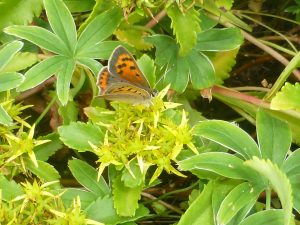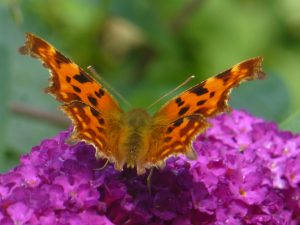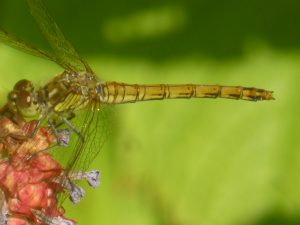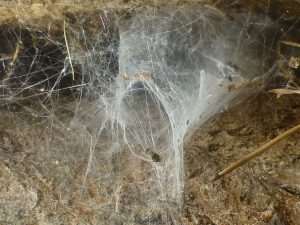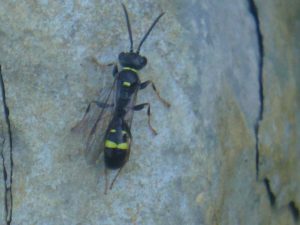July 2014 was sunny, sunny, sunny, and WARM. By the end of the month, despite a few days with some early mist and even some rain, things were looking a little dry in some parts of the Garden and some plants finished flowering earlier than usual. The month was marked by the passing of the 700-species milestone on 6th, when local bumblebee expert David Adamson spotted Tree Bumblebee Bombus hypnorum on some Hypericums. Eleven species in total were added to the Garden’s list during the month, bringing it up from 698 to 709.
Butterflies — July 2014 was an amazing month for butterflies in the Garden so I’m starting with them for a change. There were 34 sightings of 10 different species, bringing the total for 2014 up to 13 species, only two short of the entire Garden list of 15 recorded over ten years or so. Apart from lots of Green-veined and Small Whites there was a Large White on 9th. A second-brood Holly Blue was seen on 24th, making 2014 one of the few years when both broods of this species have been successful in the Garden. A migrant Painted Lady was present on 10th, a Small Tortoiseshell on 14th and a Red Admiral on 20th. Meadow Brown was seen in the Ecological Meadow area on 22nd, while the month ended with a Small Copper in the Rock Garden (29th) and Comma around the Pond and Glasshouses areas on 30th and 31st.
Other insects – Apart from the Tree Bumblebee that was ‘Species 700’, and which was also seen on 24th and 30th, Field Digger Wasp was another new hymenopteran record for the Garden (15th; also 22nd and 28th). Unlike the Tree Bumblebee, which had been expected to turn up, this came as something of a surprise. It’s mainly a species of the coast, but some have taken a liking to the sand and vertical slabs next to the new Alpine House. So we have not only created a new habitat for alpines, but a new habitat for wildlife. Edinburgh’s Wool Carder Bees were numerous in the Fruit Garden/Demonstration Garden area throughout the month and there was possible evidence from flight paths that their nest was somewhere nearby within the Garden. The Rock Garden population started flying from about the second week but the Sempervivums they favour had a very short flowering season this year and were over by the end of the month. Wool Carder Bees were, as in 2013, also seen near the Pond. Ten other species of solitary bee were also recorded in July.
A Black Darter dragonfly by the main Pond on 23rd was the first record since at least 2006. A Common Hawker dragonfly was recorded on 18th while Azure Damselflies continued flying at the Scottish Heath Garden pond in the first half of the month (6th, 11th).
Hoverflies, apart from a couple of species, remained few and far between, continuing the trend for the year so far. Despite all the sunshine not many were flying and many usually common species remained stubbornly absent or almost so. Eleven species were recorded. Marmalade Hoverflies were seen daily (except 30th, which was wet) from 14th. The other two most commonly seen were Banded Hoverfly and the drone-fly Eristalis intricarius. August is often the peak month for hoverfly abundance at Edinburgh so we’ll have to wait and see what this year’s brings. Another three fly species were added to the Garden’s list, all on 24th: Lucilia sericata, Rhagio vitripennis and Suillia affinis.
24th July, when I was recording on the wooded slope at the east edge of the Chinese Hillside, also yielded a new bug record for the Garden: Campyloneura virgula. In contrast to June, only three beetle species were seen: Red Soldier Beetles on ten days throughout the month, Common Pollen Beetles in the capitula of Ligularia and Inula around the Pond (17th, 29th) and Viburnum Leaf Beetle, a rather unwelcome new Garden record on 23rd when I was alerted by one of the horticultural staff to identify dozens of them that were defoliating a Guelder Rose bush (Viburnum opulus) near the John Hope Gateway.
Twenty-one species of leaf-mining fly were recorded, with two of them being new Garden records, as well as seven leaf-mining moths (one of those also being a new Garden record). Seven gall-forming mites were recorded. The spider Segestria senoculata was another interesting new Garden record: this forms a funnel-like web in the cracks of tree bark and was found on a Robinia on the Oak Lawn.
Birds took a back seat during July. Birdsong lessened such that, by the end of the month, the Garden was a very quiet place. Most species, from the Mallards on the pond to the Robins, Blackbirds and thrushes, had gone into moult and were hard to find. One exception was Chiffchaff which continued singing almost throughout the month although even it seemed to have stopped by the month’s end. A Nuthatch was seen on 2nd, going down one branch of a Sycamore tree on which a Great Spotted Woodpecker was climbing up another branch at the same time! A Kingfisher was present on the Pond on 4th. A Collared Dove was sadly found dead on 20th. The Sparrowhawks fledged four young out of the six eggs that hatched. The full list of 38 bird species recorded at the Edinburgh Garden in July was: Blackbird, Blackcap, Black-headed Gull, Blue Tit, Bullfinch, Buzzard, Carrion Crow, Chaffinch, Chiffchaff, Coal Tit, Collared Dove, Dunnock, Feral Pigeon, Goldcrest, Goldfinch, Great Spotted Woodpecker, Great Tit, Greenfinch, Grey Heron, Herring Gull, House Martin, Kingfisher, Lesser Black-backed Gull, Long-tailed Tit, Magpie, Mallard, Moorhen, Nuthatch, Robin, Song Thrush, Sparrowhawk, Stock Dove, Swallow, Swift, Tawny Owl, Tree Creeper, Wood Pigeon, Wren.

